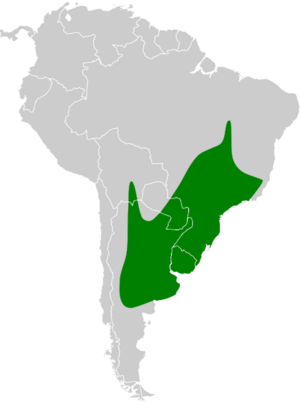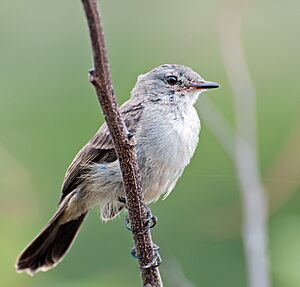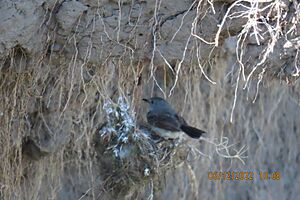Sooty tyrannulet facts for kids
Quick facts for kids Sooty tyrannulet |
|
|---|---|
 |
|
| Conservation status | |
| Scientific classification | |
| Genus: |
Serpophaga
|
| Species: |
nigricans
|
 |
|
| Distribution of S. nigricans Year-round | |
The sooty tyrannulet is a small bird. It belongs to the tyrant flycatcher family. Its scientific name is Serpophaga nigricans.
This bird is tiny, about 12 centimeters long. It usually weighs around 9 grams. It has gray or brownish-gray feathers. Its tail feathers are black.
You can find it in countries like Argentina, Brazil, Uruguay, and southern Paraguay. It also lives in a small part of southeastern Bolivia. It likes to live near rivers and in wet shrublands or swamps.
Contents
About the Sooty Tyrannulet's Name
The sooty tyrannulet was first described by a French bird expert. His name was Louis Pierre Vieillot. He based his description on notes from a Spanish officer, Félix de Azara, in 1805. Azara had called it "Tachuri obscurito menor" in Spanish.
In 1817, Vieillot gave it the scientific name Sylvia nigricans. Later, in 1927, another bird expert, Carl Eduard Hellmayr, put it in the group of birds called Serpophaga. He gave it the name Serpophaga nigricans. This bird does not have any different types or subspecies.
Scientists once thought it was most like Urich's tyrannulet. But a study of its mitochondrial DNA showed something new. It is actually most closely related to the torrent tyrannulet.
What Does the Sooty Tyrannulet Look Like?
The sooty tyrannulet is mostly dark gray. Its upperparts (back and top) have a brownish tint. Its underparts (belly) are lighter. The top of its head is a bit darker.
It has a white stripe on its crown (top of head). This stripe is usually only partly seen. Its chin is whitish. On its wings, it has two light gray wingbars. The flight feathers closest to its body are whitish. Its tail is black.
This bird has brown eyes and a black beak. Its legs are also black. Male and female sooty tyrannulets look the same. Young birds have not been described yet. The sooty tyrannulet is usually about 11.8 to 12.7 centimeters long.
The song of the sooty tyrannulet is a series of short notes. These are followed by higher-pitched notes. People have said these sound like a "canary." It also makes a sharp "teek" sound. Breeding pairs have been heard making quiet trills and chatters to each other. Adults also make a more complex sound when a fledgeling (young bird) comes near them.
Where Do Sooty Tyrannulets Live?
The sooty tyrannulet lives in Tarija in southern Bolivia. It is also found in Paraguay, and southern Minas Gerais and Espirito Santo in southeastern Brazil. You can also find it in southern and central Argentina, and Uruguay.
Since 2010, it has also been seen in Tocantins in Brazil. It had never been recorded there before. The sooty tyrannulet usually does not migrate. However, the birds living furthest south might fly north after the breeding season.
Sooty tyrannulets are often found near streams, rivers, and water bodies. They can also be found near farms. They like brushy areas close to water. Sometimes, they can be found in forests far from water. They live from sea level up to about 1,000 meters high.
How Sooty Tyrannulets Live and Eat
The sooty tyrannulet eats insects. When it hunts for food, it makes many short flights. It flies from one perch to another. It almost never lands on the ground. It quickly darts into the air to catch insects. It can also catch insects from the surface of the water. It often wags its tail while it is looking for food.
Reproduction and Life Cycle
Sooty tyrannulets build their nests and lay eggs between October and December. Both the male and female birds help build the nest. Nests are often built on a branch under something that hangs over it. Sooty tyrannulets might even build nests near human structures, like bridges.
The nest is shaped like a cup. It is about 10 centimeters deep and 4 centimeters wide. It is made of tightly packed roots and grasses. The inside of the cup is lined with soft feathers. The sooty tyrannulet usually lays three eggs.
Scientists do not know how long the parents incubate their eggs. They also do not know how long it takes for the hatchlings (baby birds) to start to fledge (learn to fly). Sometimes, Shiny cowbirds lay their eggs in the sooty tyrannulet's nest. This is called Brood parasitism.
Is the Sooty Tyrannulet in Danger?
The International Union for Conservation of Nature says the sooty tyrannulet is a species of least concern. This means it is not in danger of disappearing. We do not know exactly how many there are. But experts believe their numbers are stable.




